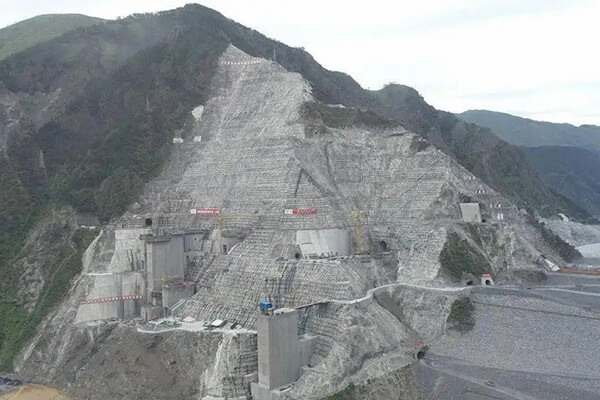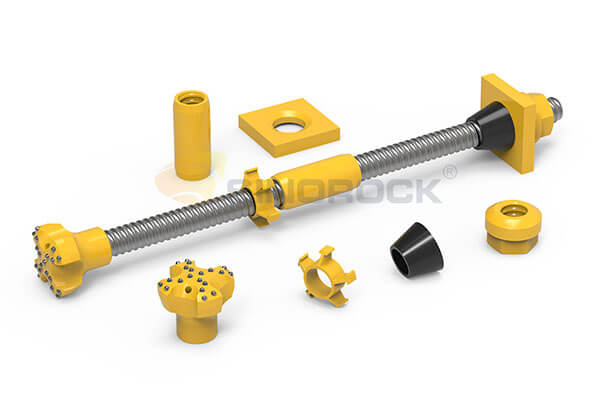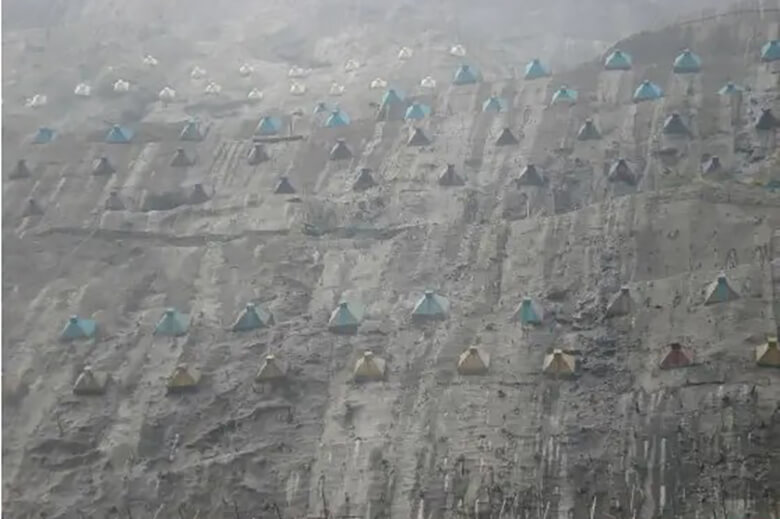Rock Anchors for High and Steep Slope Stability of A Nuclear Power Plant
Time:2024-07-05From:sinorock View:
In engineering construction, particularly for critical infrastructure such as nuclear power plants, geological disasters like the collapse of high and steep slopes and landslides can result in catastrophic losses. These losses not only endanger the safety of the engineering structures themselves but also pose significant risks to the lives of workers and nearby communities. Therefore, the reinforcement and protection of slopes are paramount in ensuring the stability and safety of such projects.
One of the most effective techniques for slope protection is the use of self-drilling rock anchors. This method is a modern, innovative solution that integrates drilling, grouting, and anchoring in a single, streamlined process. This article delves into the features, benefits, and implementation of self-drilling rock anchors, particularly focusing on their application in stabilizing high and steep slopes at nuclear power plant sites.

Features of Self-Drilling Rock Anchors
Self-drilling rock anchors are a groundbreaking technology that combines multiple functions into one efficient process. Here are the key features that make them highly effective for slope stabilization:
1. Integrated Drilling, Grouting, and Anchoring
The self-drilling rock anchor system is designed to perform drilling, grouting, and anchoring simultaneously. The anchor rod itself serves as the drill pipe, eliminating the need to remove it after drilling. The hollow core of the anchor rod acts as the conduit for grouting, allowing the grout to flow from the inside out. This integrated approach simplifies the construction process, making it faster and more efficient.
2. Versatility in Various Rock Conditions
Self-drilling rock anchors can be used under a wide range of geological conditions without requiring additional measures such as wall protection or pre-grouting. The anchor rod’s three-in-one functionality ensures the formation of anchor holes and effective grouting and anchoring, even in unstable or fractured rock environments.

3. Customizable Length and Flexibility
The anchor rods can be cut, connected, and extended as needed, making them suitable for use in confined construction spaces. This adaptability allows for the implementation of long anchor rods to reinforce the surrounding rock, thereby enhancing stability.
4. High-Efficiency Grouting
The high-efficiency grouting plug keeps the grouting at high pressure, fully fills the gap, and consolidates the broken rock mass. The use of high-strength backing plates and nuts ensures that the stress from the deep surrounding rock is evenly distributed to the cave wall, providing robust support.
Project Overview: Slope Stabilization at a Nuclear Power Plant
A nuclear power plant project presented a challenging scenario involving the stabilization of a high and steep rock slope on the west side of the main plant area. The slope had partially collapsed due to rain erosion and blasting activities. To ensure the stability and safety of the site, a comprehensive local protection and reinforcement plan was implemented, focusing on the use of self-drilling rock anchors.
Repair of Defects
The initial step involved repairing the parts of the slope where collapses and over-excavations were significant. C15 concrete was used for these repairs, and the concrete was transported vertically using spraying technology.
Anchor Rod Installation
For anchoring, a self-drilling hollow anchor rod system was employed. The anchor rods had an outer diameter of 27mm, and the drilling holes were 80mm in diameter. The length of the anchor rods ranged from 6m to 12m, with standard lengths of 6m being extended through rod connections.
Key Points of Construction Technology
The construction of self-drilling rock anchors involves a series of precise steps to ensure optimal performance and stability. Here’s a detailed breakdown of the construction process:
1. Drilling the Anchor Holes
The process begins with using a bolt drill to install the drill bit and drill the anchor hole to the designed depth. This step requires careful handling to ensure accuracy and stability.
2. Sealing the Hole
Once the drilling is complete, the drilling rig is removed, and a slurry stopper is installed in the anchor hole about 25cm from the orifice to seal the hole. In cases where high grouting pressure or fractured surrounding rock is present, additional sealing measures, such as using an anchoring agent, may be necessary.
3. Grouting Connection
The tail end of the anchor rod is then connected to a specialized grouting machine via a quick joint. This connection ensures that the grout is delivered efficiently and effectively.
4. Grouting Process
The grouting machine is started, and grouting continues until the anchor hole is fully grouted and the required pressure is reached. The grouting pressure is determined based on calculated parameters and the performance capabilities of the grouting machine.
5. Installing the Backing Plate and Nut
Finally, according to design requirements, a high-strength backing plate and nut are installed. This step ensures that the stress is evenly distributed, providing robust support to the surrounding rock.
Advantages of Self-Drilling Rock Anchors in Slope Stabilization
The self-drilling rock anchor system offers several advantages over traditional grouting bolt methods, making it a preferred choice for slope stabilization in challenging environments like nuclear power plant sites. Here are some of the key benefits:
1. Enhanced Construction Efficiency
The integrated drilling, grouting, and anchoring process significantly improves construction efficiency. Studies and practical applications have shown that the construction efficiency of self-drilling rock anchors is over 30% higher than that of traditional methods.
2. Improved Stability and Safety
The high-pressure grouting ensures that all gaps in the fractured rock mass are fully filled, providing superior stability. The even distribution of stress through the backing plate and nut further enhances the safety and stability of the slope.
3. Cost-Effectiveness
Despite the advanced technology involved, self-drilling rock anchors are cost-effective. The reduction in construction time and labor, combined with the increased stability and reduced need for maintenance, results in overall cost savings.
4. Versatility and Adaptability
Self-drilling rock anchors can be used in a variety of geological conditions without requiring additional measures. Their ability to be cut, connected, and extended makes them suitable for a wide range of applications, including confined spaces and challenging rock environments.

Future Prospects and Innovations in Slope Stabilization
As technology continues to advance, the methods and materials used in slope stabilization are also evolving. Self-drilling rock anchors represent a significant step forward, but ongoing research and development are likely to bring further improvements and innovations.
Emerging Technologies
New materials and technologies are being explored to enhance the performance of self-drilling rock anchors. These include advanced grouting materials, improved drilling techniques, and innovative anchor rod designs.
Integration with Monitoring Systems
The integration of self-drilling rock anchors with advanced monitoring systems is another area of development. These systems can provide real-time data on the stability of the slope, allowing for proactive maintenance and intervention.
Environmental Considerations
Environmental sustainability is becoming increasingly important in engineering construction. Future developments in slope stabilization will likely focus on minimizing environmental impact while maximizing stability and safety.
Conclusion
Self-drilling rock anchors are a highly effective solution for stabilizing high and steep slopes, particularly in critical infrastructure projects like nuclear power plants. Their integrated drilling, grouting, and anchoring process, combined with their versatility and adaptability, make them an ideal choice for challenging geological conditions.
The case study of the nuclear power plant demonstrates the practical benefits of self-drilling rock anchors, including enhanced stability, improved construction efficiency, and cost-effectiveness. Their ability to provide robust and reliable slope stabilization makes them an invaluable tool in ensuring the safety and stability of critical infrastructure projects.
latest news
-

- What Are the Applications of SDA Bolts in Hydropower Stations?
- Time:2025-08-21From:This Site
- Learn how self-drilling anchor bolts enhance slope stability, tunnel support, and dam reinforcement in complex geological conditions at hydropower stations. Optimize hydropower projects with efficient, cost-effective, and eco-friendly solutions.
- View details
-

- Slope Stabilization with SDA Bolts: Benefits & Applications
- Time:2025-08-19From:This Site
- Discover how self-drilling anchor bolts (SDA bolts) provide superior slope stabilization for highways, railways, and tunnels. Learn their key benefits, installation process, and real-world applications in loose or collapsible soils.
- View details
-

- How Self-Drilling Rock Bolts Enhance Tunnel Support in Fractured Rock?
- Time:2025-08-15From:This Site
- Discover how self-drilling rock bolts enhance tunnel support in fractured rock. Learn their benefits, installation steps, and real-world applications for safe, efficient tunneling.
- View details
-

- Sinorock 2025 Quality Month | Strengthening Quality Foundations, Empowering Product Excellence
- Time:2025-08-13From:This Site
- Sinorock’s 2025 Quality Month, themed “Strengthening Quality Foundations, Empowering Product Excellence,” successfully concluded, reinforcing our commitment to superior product quality.
- View details
-

- Sinorock Safety Month 2025 | Everyone Speaks Safety, Everyone Can Respond
- Time:2025-07-03From:This Site
- Sinorock Safety Month 2025, centered on the theme "Everyone Speaks Safety, Everyone Can Respond - Spot Workplace Hazards," has wrapped up successfully!
- View details
-

- Quality Control: the Vital Factor of A SDA Bolt Factory
- Time:2025-01-09From:This Site
- Sinorock’s comprehensive quality control system, from supplier management to outgoing inspections, ensuring the highest standards for self-drilling anchor bolts in construction.
- View details
-

- Sinorock Invites You to Explore Proven Self-Drilling Anchor Bolt Solutions at bauma 2025
- Time:2025-03-07From:This Site
- From April 7–13, 2025, explore Sinorock’s Self-drilling anchor bolt solution at Booth C2.513/4 in Hall C2 of the Messe München Exhibition Center (Munich, Germany).
- View details
-
.jpg)
- SINOROCK to Attend EXPOMINA PERÚ 2024 in Lima, Peru
- Time:2024-08-10From:This Site
- Sinorock to Attend EXPOMINA PERÚ 2024 in Lima, Peru
- View details
-
.jpg)
- SINOROCK to Participate in MINING AND METALS CENTRAL ASIA 2024
- Time:2024-08-08From:This Site
- SINOROCK to Participate in MINING AND METALS CENTRAL ASIA 2024
- View details
 Download
Download 


